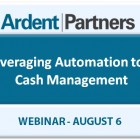How can AP impact working capital? Well, in many cases, in an effort to improve working capital positions enterprises will decide to withhold payments and aggressively push for extended terms. However, there is a danger that this can become a standard practice which can harm supplier relationships and potentially disrupt the buying organization’s business operations.
A more sustainable approach that will yield more benefits in the long-run is to streamline the larger procure-to-pay process and, more specifically, streamline the AP process to ensure greater efficiency and visibility across the department. Visibility and accurate real-time data into current and future liabilities gives AP more control and precision around the outflow of cash thereby improving the management of working capital. (Read AP + Treasury = Working Capital Optimization)
However, streamlining AP operations is a challenge especially when an AP group is operating in a manual and paper-based environment, making it extremely difficult for AP to be a source for working capital improvements. Here are three strategies that can help to improve the impact that AP can have on working capital:
Migrate off paper, by any means necessary – Removing paper from the AP process should be a top priority for AP leaders. Take whatever method is most accessible and appropriate for your organization to move away from paper-based invoices and payments. One approach to consider is the multi-solution or portfolio approach to removing paper. In this strategy, groups may utilize eInvoicing and put in place strategies to maximize the number of invoices received in this manner while also deploying scan and capture capabilities to handle those suppliers that continue to send paper invoices. Establish migration goals and track the percentage volumes for both manual and electronic invoices and payments to ensure the targets are met. This strategy can impact working capital by enhancing visibility across AP and speeding up the process to approve an invoice and make a payment – helping to avoid late payment penalties and capture more early payment discounts.
Include an electronic payments strategy as part of the overall AP transformation – An AP transformation effort should also include a plan to migrate away from manual and paper-based payments. Electronic forms of payment or ePayments (e.g., card products, ACH/EFT, wire transfers) offer significant cost savings versus manual methods as well as improved security, more precision, and visibility into payments, all of which are a necessary part of optimizing working capital. A supplier enablement effort should include a strategy around improving the acceptance of various forms of ePayments among the supplier community. More on ePayments here
Develop a supplier enablement strategy – One of the biggest challenges to a successful AP automation initiative is enabling a majority of the supply base to submit eInvoices and/or accept or ePayments. Therefore, once a solution is selected, it is important to develop a plan to enable as many suppliers as possible in the shortest timeframe available. A strong and well-managed communication campaign can make the difference between a small percentage or a sizeable majority of suppliers being on-boarded. The execution of the communication is as important as the message itself: make sure that the right suppliers receive the right message.


